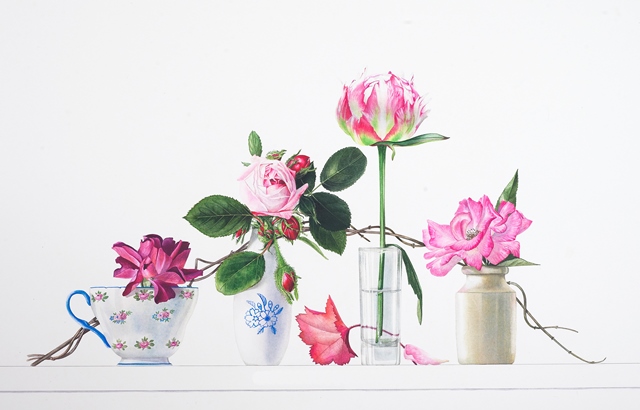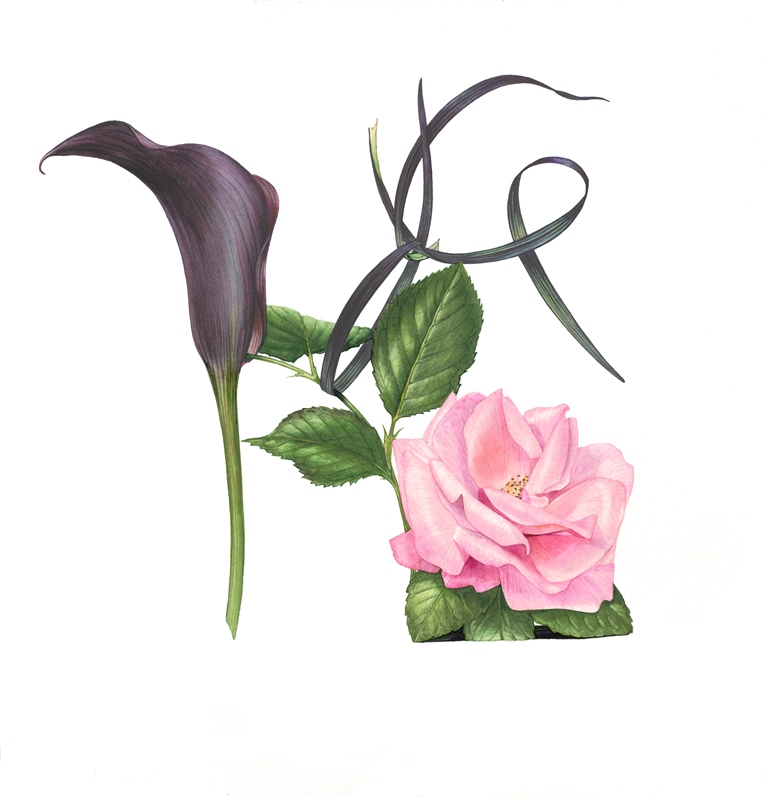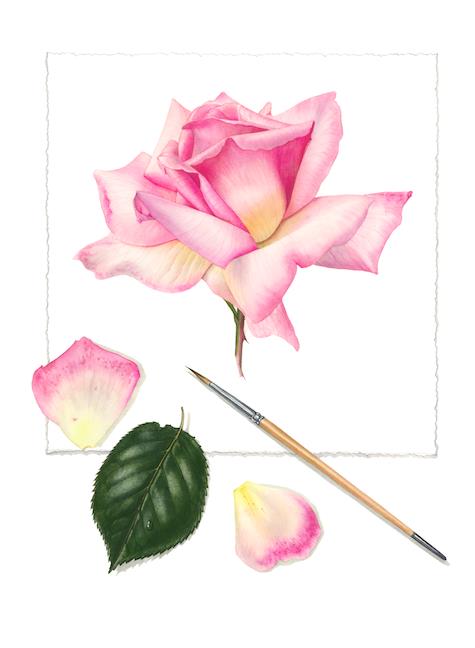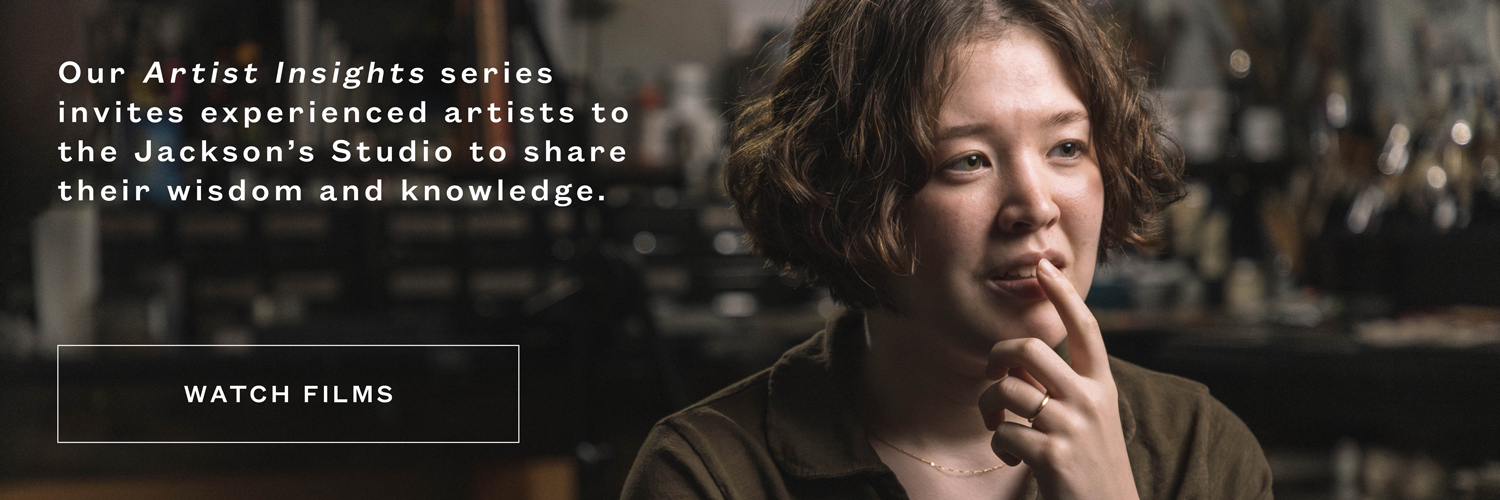Billy Showell is a watercolour artist and founder of the Billy Showell School of Botanical Art, which she established to share her knowledge and love for botanical watercolour painting. Billy visited the Jackson’s Studio to share the story of how she started working with watercolour, and why she wanted to teach others what she has learned along the way.
Artist Insights: Billy Showell
Contents
0:00 “I am just one of many that are just trying to bring the natural world into focus”
0:25 Introduction
0:48 “I was always that sort of quiet child that was sitting in the corner drawing and painting”
1:53 “Once I got to art school and I found my people”
2:24 “I should be living and breathing fashion”
3:15 “A formative time in my life”
4:37 “Well if you can paint those beautiful flowers on furniture, why don’t you paint it onto canvas”
5:55 “I’d found a little niche that suited me”
6:29 “You don’t see petals are fused at the base and burst open”
7:52 “My career as a Botanical illustrator is different to my career as a Botanical artist”
8:39 “I think as long as Botanical art has its feet in history, it can have its head in the clouds”
9:04 “I’ve always resisted calling myself a Botanical artist and I know that sounds strange because that’s what I am”
9:49 “Celebrating the beautiful forms that the natural world give us”
10:40 “Well you can’t just join, you have to apply”
12:01 “I think I broke all of the rules”
12:33 “He’s broken all the rules by somehow it works”
12:52 “If analyse something too much you break it”
13:23 “Watercolour is one of those mediums where you need really good pigments”
13:52 “Looking for more spring in my brush”
15:06 “My brush that removes all mistakes, most of them”
15:24 “Paper is an obsession with Botanical painters”
16:52 “Religiously I always add water first”
18:44 “If someone said they couldn’t use French Ultramarine or Cobalt Blue, I’d probably run for the hills screaming”
19:11 “Always looks very chaotic but its organised chaos”
19:55 “I’m definitely a night owl”
20:34 “When I’ve got a big deadline I have complete silence”
21:38 “I do a lot of playing around”
22:36 “The amount of detail or fiddling I do, I don’t even count the hours”
23:25 “A couple of times I have actually physically put my painting in a bin, and then retrieved it later on”
24:28 “Be in the state of mind that this is for me, this is my time”
25:45 Credits

Extract
I grew up in a house where there were lots of art materials, and I was always that sort of child who was sitting in the corner, drawing,and painting. I’ve always been interested in art and loved it all the time I was in junior school. At secondary school, I decided to pursue art, but I had to discuss it with the headmaster, as the school didn’t encourage it. A funny moment happened when I went to say goodbye, and he asked why I hadn’t focused on sciences. I told him I wanted to be an artist, and he said there wasn’t much of a career in art. I pointed out that everything he was wearing, the car he drove, and the building he was sitting in had probably all been designed by someone who started at art school. I think he was a bit taken aback.

Billy on a sixth form school trip to Amsterdam
When I was thinking about leaving secondary school I thought, I fancy going to art school and maybe studying fashion. I did a two-year foundation course at Epsom Art School, and then I went to St. Martin’s for a three-year design and illustration course.
Once I got to art school and found my people, the whole world opened up for me. There were so many different people on the course, all living and breathing fashion and I suddenly thought, actually, I should be living and breathing fashion. It just seemed a natural fit for me. And I loved doing the work. I was one of those students who was there till late working. The part of it that I really liked was the illustration side of it.

Billy in Paris during the second year of study at St. Martins
When I left I worked in the high street fashion scene at Wallis. I was there probably about two and a half years, not very long. And it was quite a formative time in my life because I had met my husband, who was working as a model maker. One day I just turned up and I said, my feet hurt. I don’t want to go to work anymore. I want to be an illustrator. It was a bit risky because I thought we wouldn’t have any money. But we decided that I should leave and try and work freelance. I was initially painting on furniture. And then somebody said to me, well if you can paint those beautiful flowers on furniture, why don’t you paint it onto canvas? So, I started painting classic still lifes with oil paints.

Billy’s fashion illustration
My first show was in Lincolnshire. It was my in-laws who were both art teachers. And they had a little group and we put on a show there. A chap said: “I’ll be your agent. Whatever you paint, send it to me and I’ll sell it.” So that’s what I started doing. I was painting these still lives but it wasn’t enough income. So I thought, well, actually, maybe I could start teaching this oil painting. So I took myself down to the local adult education centre, there was an open evening where you get people to sign up for your classes. I don’t think anybody came to my desk. And I came home quite sort of deflated and a bit miserable.

Billy’s fashion illustration
That summer I decided that I would start painting watercolour. I practiced and practiced and then I went back to the adult education centre and I said to them, maybe I could teach watercolour. And I sat at the table waiting for everyone to sign up. Suddenly I was surrounded by people and I got loads of people signing up for my course. I think probably I was only a few steps ahead of them when I started teaching, but I just had this feeling that this was something I was really going to be good at. I could teach in the evening and look after the kids during the day. So that was my next phase in illustration quite by chance. I’d been teaching evening classes in general, sort of watercolour and still life. The head of the Education Center said, “Could you run a course on botanical painting or botanical illustration?” And I seriously said to him, “What’s that?”

Billy’s fashion illustration
I went down to the library to see what he was talking about and found several books on the subject. I thought, “This is lovely.” Just painting the plant, without any background, really focuses all the attention on it. When you study a plant so closely, you start noticing things you’d never normally see, like how petals fuse at the base and then burst open, or how leaves attach and are covered in tiny hairs. It’s full of fascinating details that can ignite children’s imaginations and make learning about painting and art a lot of fun.

Apples and Fabric, 1996
Billy Showell
Oil on canvas, 30 cm x 25 cm | 11.8 x 9.8 in
There were huge shows at the Central Westminster Gallery, and it was overwhelming to see so much work. The painters I met there were some of the loveliest people, very guiding and motherly, helping me along. I remember going to the first exhibition and asking to join, but they told me I had to apply. When I asked how, they gave me an application form and told me I needed to produce five highly detailed paintings and get them accepted for three consecutive years – quite a tough task. The society had a broad range of design and art, but the panel was strict. I applied and, I think, got in on my second try, though I broke all the rules. In botanical illustration, you’re supposed to paint at actual size or indicate any enlargement with symbols.

Agapanthus and Peony, 2003
Billy Showell
Watercolour on paper, 30 x 50 cm | 11.8 x 19.6 in
When my work was first exhibited, they didn’t know I was female because my name was spelled with a Y. I stood on the other side of the painting and overheard people saying, “He’s broken all the rules, but somehow it works.” I was fascinated by the rules I had broken.
I got chatting with other artists who pointed out that my compositions were unique, something I hadn’t realised I was doing differently. I always thought that over-analyzing things would ruin them, so I just kept doing what worked. I’ve now been a member of the SBA for over 20 years, and it’s been fundamental to my journey. Meeting other artists and discussing techniques, paper, plants – everything I needed to know – was incredibly helpful.

Agapanthus, 2006
Billy Showell
Watercolour on paper, 30 x 50 cm | 11.8 x 19.6 in
Botanical illustrators, if they’re employed in an official capacity, are illustrating plant archives. They have to follow a specific plan of how the painting is laid out as it is a way of identifying plants. So that if you were out in the field, you would have a really good description and painting to refer to. Botanical painting is more about portraying a plant beautifully and accurately, with a bit more artistic license. I was pushing my watercolour skills, but not necessarily the scientific side. I’ve always aimed to make my paintings beautiful and interesting. People have mixed opinions about botanical art, sometimes seeing it as lacking expressiveness, but so many personal elements of my life go into my work. It’s a genre that’s growing, and I think so long as it’s got its feet in history it can have its head in the clouds.

Aubergine, 2005
Billy Showell
Watercolour on Khadi paper, 40 cm x 50 cm | 15.7 x 19.6 in
I’ve always resisted calling myself a botanical artist. And I know that sounds strange because that’s what I am. I wanted to be a painter. I think of myself as an artist. I’m in a group of artists who choose flowers from unusual angles and moments in time. There are some amazing artists that do fading flowers.
I often have several paintings on the go and you can as a botanical painter, because sometimes a flower has gone out of season or something. It just died and you’ve got to wait a whole year for it to come back into the garden. When I’m planning a painting, sometimes it’s purely organic. I’ll just go into the garden. I’ll find whatever I want to paint. I place it aesthetically on the paper, hovering it just above the paper. I decide which angle I’m going to go for and then I put it down. And somewhere in that process of getting the flowers or getting the plant material together, I have like an image in my mind of where I’m going to take it.
I don’t have a sketchbook, so I keep my work in folders. I’m always thinking of the themes and I’m always playing around with the composition, but there tends to be little stories that come together and then I’ll group those together.
The botanical illustrator who’s influenced me most is Pandora Sellars, with her beautiful way of combining plants. Another key figure in the botanical world is Rory McEwen, who could do it all – starting as a musician, then an abstract artist, but most famous for his large watercolour paintings of leaves on vellum. William Morris is another artist I admire, with his stunning patterns and stylized depictions of nature. I’ve always used flowers as a starting point for shapes and inspiration.
I’m really lucky. My husband built me a studio on the foundations of an old polytunnel. It is a really lovely space that I can teach small classes in and have a very long desk that I found at an old antique shop. It always looks very chaotic, but it’s organised chaos. A normal day for me would be to get the business side out of the way, and I have a little online shop, so I pack my parcels. And by about 4 o’clock, I feel inspired to go to my studio and paint.
I always think the best way to go is to keep your palette small but buy the best materials. I’ve been using the same colours for a long time. I started with Winsor & Newton but now I work with Sennelier and I love their range of colours. Most of my palette is transparent and lightfast, but I occasionally add a new colour I find and love. And I think that’s the way you should work as an artist. I think you shouldn’t restrict yourself too much.
I use synthetic brushes along with a set of tool brushes. One is a large brush which I call a Devine Wash brush, which is for big paintings, as it holds a lot of water. Then, I have my mixing brush, which gets the most use when I’m mixing colours. For finer details, I use smaller brushes, like a Fine Liner for dry brushing and fine lines. My Eradicator brush helps me fix most mistakes, and I have a tiny spotter brush for adding delicate spots to flowers without creating lines.
Paper is an obsession with botanical painters. I’ve gone through quite a lot and have settled on Saunders Waterford Hot Pressed, in high white. I used to use the traditional white, which has a colour to it, a slightly sort of off-white creamy colour. But when you’re printing your paintings or doing sort of cards or publishing them, sometimes that colour is red as a colour in the printer. So it doesn’t give it that lovely clean, pristine white background that we look for in botanical art. And we tend to always use hot pressed. Although sometimes it’s quite nice to use cold pressed when you’re just practicing and getting to know botanical processes. The difficulty is the more textured the paper, the harder it is to get the crisp outlines of the plants.
I would go for 100% cotton paper. Certainly when I’m painting artwork for an archive, then it needs to be on 100% cotton paper. But there are loads of papers out there now. The woodfree paper, Bockingford, that I use is quite nice just for general practice. Historically speaking a lot of botanical illustration was done with the process called dry brushing where you’re just using a very small amount of paint and very small brushes and just applying the paint very very delicately even over large areas they would just use this very slow small brush process.
I came to botanical painting through my fashion illustration background and I used a process called wet-in wet. When I was doing my fashion illustrations I had to work quite fast so I would work with wet paint. To capture highlights on petals and leaves, I realised adding water to hot press paper first was the way to achieve that blend of light to dark. I always add water first to the area that I’m painting and then drop the colour into it. Not only is this a faster way of working than the traditional way, but it’s also something that celebrates the medium that I’m using.

Longiflorum Lilies, 2016
Billy Showell
Watercolour on paper, 25 x 30 cm | 9.8 x 11.8 in
Sometimes, watercolour creates textures better than I could, adding a lovely softness, especially with rose or peony petals, where you get a beautiful graduation of light to dark and soft edges. The wet-in-wet technique is something I’ll always use. Granulation is where you get this textured finish, almost like little spots of colour amongst a nice smooth glaze. Sometimes you get a little bit of granulation and it’s just the perfect texture for that plant.
I get asked how long it takes to paint a painting. It depends on the size, obviously, and it depends on the amount of detail that you’re going to put in, how fussy you’re going to be, and how many images you’re going to put onto the piece of paper. It takes about a day to map one flower. When I say map, it means getting some paint on the paper and maybe analyzing some of the values across the flower. And then for the amount of detail or fiddling that I do, I don’t even count the hours. So I’ll come back in, I’ll stand a painting at the other end of the room and I’ll think, “No, it needs a bit more shade and a bit more, know, intensity of colour.” Then I’ll get up close, I put my spectacles on and I think, “Oh, no, I haven’t put enough detail in and that’s wrong and that’s right and I need to fiddle with it a bit more.” So I’d say a majority of my sort of small to medium paintings take about a week if I were to add all the hours together.

Still life in pink,2015
Billy Showell
Watercolour on paper, 50 x 30 cm | 19.7 x 11.8 in
A lot of people worry when they’re painting that they’re going to overwork something. And that is a risk when you’re painting something as a sort of portrait of that plant and you’re wanting to be really exact. It’s very difficult sometimes to know when to stop. I think when you are looking at your painting sometimes it’s quite nice to stop and offer it up to the mirror. This is what I do sometimes. And then I’m seeing it with fresh eyes.
Of my favourite things to say, which I think helps my students, is that we’re not photocopy machines. We’re not looking to replicate the photograph. We’re looking to make a painting, a portrait of that plant, a little bit of us must be in the painting. So stop when you feel that it has enough poetry to stand on its own.

A Passion for Peonies, 2017
Billy Showell
Watercolour on paper, 60 x 100 cm | 23.62 in x 39.37 in
So if you were going to start a botanical painting journey, are we going to call it a journey? The thing that I always tell people to do is start with the flowers or the plants that you love. So if you are particularly mad on houseplants, that would be where you would start. You would start painting your favourite houseplant. And then moving on from that, you’ve obviously got to sort of find out about colour. So keep keeping your palette very simple. Try mixing your greens yourself. Try the plants at different angles and just basically have fun with your art.
Further Reading
Jackson’s Curated Sets for Botanical Watercolour, Lino Printmaking and Oil Painting
A Guide to Watercolour Painting
Inside the Sketchbook of Lisa Takahashi
Recreating the Colour Palette of Eric Ravilious
Shop Watercolour Painting on jacksonsart.com




